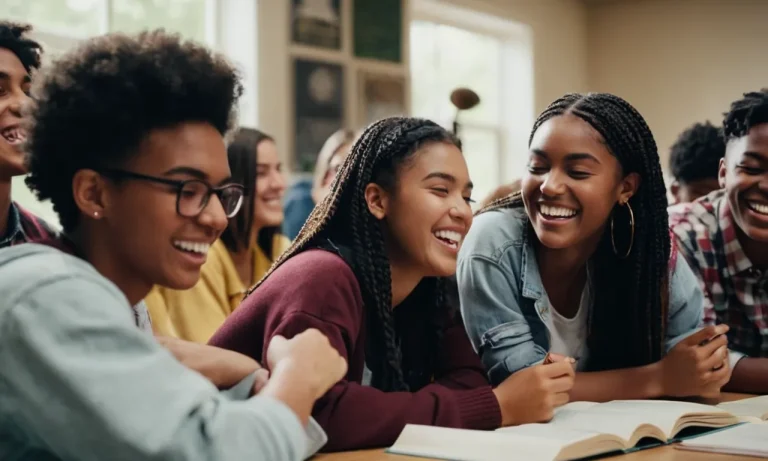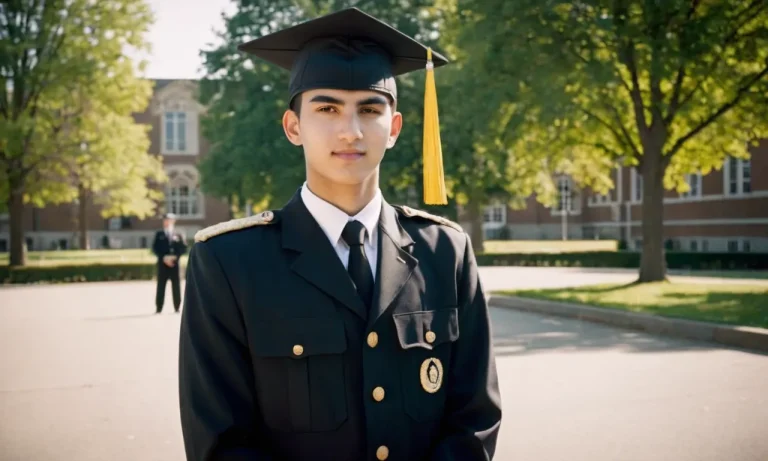Homecoming – a cherished tradition that marks the beginning of a new school year, filled with excitement, nostalgia, and a sense of unity. For many high school students, this event is a highlight of their academic journey, but when exactly does it take place?
If you’re short on time, here’s a quick answer to your question: Homecoming typically occurs in the fall semester, usually around September or October, for most high schools in the United States.
However, the timing and traditions surrounding homecoming can vary depending on the school district and region. In this comprehensive guide, we’ll delve into the details of homecoming, exploring its origins, significance, and the various factors that determine when it’s celebrated.
Whether you’re a current high school student, a parent, or simply curious about this beloved American tradition, this article will provide you with a wealth of information to enhance your understanding.
The Origins and Significance of Homecoming
The History of Homecoming
The tradition of homecoming dates back to the early 20th century, when alumni from colleges and universities were invited back to their alma maters to celebrate and reconnect with their former schools.
The first recorded homecoming celebration took place in 1911 at the University of Missouri, where the event was initially called “the annual Home-Coming”. According to Britannica, the idea quickly spread to other institutions of higher learning, and by the 1920s, homecoming had become a widespread tradition across American college campuses.
As the concept of homecoming gained popularity, it eventually trickled down to high schools, where it evolved into a celebration of school spirit and community. Today, homecoming is a cherished tradition in many high schools across the United States, typically held in the fall semester and featuring a variety of events and activities, such as football games, dances, parades, and the crowning of a homecoming king and queen.
It is a time for students, alumni, faculty, and the community to come together and celebrate their shared connection to the school.
Homecoming as a Celebration of School Spirit
At its core, homecoming is a celebration of school spirit and pride. It’s a time when students can showcase their enthusiasm for their school through various activities and events. The homecoming football game, for example, is often the centerpiece of the festivities, with students decked out in their school colors, cheering on their team, and participating in spirited chants and cheers.
The homecoming dance, on the other hand, provides an opportunity for students to dress up, socialize, and create lasting memories with their peers.
Homecoming also serves as a platform for fostering a sense of unity and camaraderie among students. According to a National Federation of State High School Associations (NFHS) study, schools with strong school spirit tend to have higher attendance rates, lower dropout rates, and better overall academic performance. 😊 The excitement and energy surrounding homecoming events can help cultivate a positive and supportive school environment, ultimately contributing to the overall success and well-being of students.
The Importance of Tradition and Community
Beyond celebrating school spirit, homecoming plays a crucial role in preserving tradition and fostering a sense of community. For many students, participating in homecoming activities is a rite of passage, a cherished experience that connects them to the rich history and legacy of their school.
It’s a time to honor the traditions that have been passed down from generation to generation, while also creating new memories and experiences that will be remembered for years to come.
Moreover, homecoming serves as a unifying force that brings together not only current students but also alumni, faculty, and members of the surrounding community. It’s a chance for former students to revisit their alma mater, reminisce about their own high school experiences, and reconnect with old friends and classmates.
This shared connection to the school creates a strong sense of community and belonging, which can be particularly valuable in today’s fast-paced and often disconnected world. 👏
Factors Influencing the Timing of Homecoming
The timing of homecoming celebrations can vary significantly between different regions and school districts. Several key factors play a role in determining when this beloved high school tradition takes place each year. Let’s explore these influencing factors in more detail:
Regional Variations
Homecoming dates often align with regional preferences and cultural norms. For instance, in many parts of the Southern United States, homecoming is traditionally held in the fall, typically in September or October.
This timing coincides with the start of the football season, a deeply ingrained part of Southern culture. Conversely, in certain Northeastern regions, homecoming celebrations may occur later in the academic year, sometimes in November or even early December.
These regional variations reflect local customs and climatic considerations.
School District Policies
Individual school districts often have established policies or guidelines that dictate the general timeframe for homecoming events. These policies may be influenced by factors such as academic calendars, exam schedules, and other district-wide events.
According to GreatSchools.org, some districts prefer to hold homecoming earlier in the fall semester to avoid conflicts with end-of-semester exams or winter break. Other districts may intentionally schedule homecoming later in the year to allow more time for planning and preparation.
Sports Schedules and Homecoming Games
The timing of homecoming is often closely tied to the school’s sports schedule, particularly football. Many high schools plan their homecoming celebrations around a home football game, known as the “homecoming game.”
This tradition stems from the idea of welcoming back alumni and celebrating school spirit. According to a survey by the National Federation of State High School Associations, approximately 75% of schools hold their homecoming during the football season.
🏈 As a result, the scheduling of the homecoming game can significantly influence the overall timing of the festivities.
It’s worth noting that while football remains the most common sport associated with homecoming, some schools may align their celebrations with other sports seasons, such as basketball or soccer, depending on regional preferences and traditions.
Typical Homecoming Activities and Traditions
The Homecoming Parade
Ah, the homecoming parade – a beloved tradition that kicks off the festivities with a burst of school spirit! 🎉 This lively event typically features a procession of floats meticulously crafted by students, bands marching to upbeat tunes, and the homecoming court waving enthusiastically from decorated cars or floats.
It’s a chance for the community to come together and show their support for the school. According to a survey by the National Association of Student Councils, over 80% of high schools across the U.S. host an annual homecoming parade, solidifying its place as a hallmark event.
The Homecoming Dance
The homecoming dance is undoubtedly the crown jewel of the homecoming celebrations. 💃🕺 Held in the school gymnasium or a rented venue, this formal event allows students to dress to the nines and dance the night away with their friends and dates.
The decorations are often themed around the school’s colors or mascot, creating a festive atmosphere. According to the National Center for Education Statistics, over 90% of public high schools in the U.S. host a homecoming dance each year.
It’s a time for students to make cherished memories and embrace the spirit of their alma mater.
Homecoming Court and Royalty
A time-honored tradition, the homecoming court and royalty add an air of prestige to the celebrations. Students are nominated and elected by their peers to represent their grade level on the court, with the ultimate honor being crowned as the Homecoming King and Queen.
The selection process often involves factors like academic achievement, extracurricular involvement, and overall school spirit. According to a survey by the National Federation of State High School Associations, nearly 75% of high schools across the nation have a homecoming court, highlighting its enduring popularity.
Alumni Reunions and Tailgating
Homecoming isn’t just for current students; it’s a time for alumni to reconnect with their alma mater and reminisce about their glory days. Many schools organize alumni reunions and tailgating events around the homecoming football game, allowing former students to catch up with old friends and relive their high school memories.
Tailgating is a beloved pre-game tradition where alumni gather in the parking lot, fire up the grills, and share stories from their school days. According to a report by Cornell University’s Alumni Affairs Office, over 60% of alumni cite homecoming as a key reason for returning to their alma mater, showcasing the enduring bond between schools and their former students.
Planning and Preparing for Homecoming
Organizing Committees and Student Involvement
Homecoming is a cherished tradition in high schools across the United States, and its success heavily relies on meticulous planning and preparation. One of the key elements is the formation of organizing committees, which typically involve a diverse group of students from various grades and extracurricular activities.
These committees play a pivotal role in coordinating every aspect of the event, from selecting the theme and decorations to organizing the dance and other festivities.
Student involvement is crucial in ensuring that the homecoming celebration resonates with the student body. According to a survey by the National Association of Elementary School Principals, schools that actively engage students in the planning process tend to have higher attendance and overall satisfaction rates.
By encouraging student participation, the organizing committees can better understand the preferences and interests of their peers, resulting in a more inclusive and exciting homecoming experience for all.
Fundraising and Budgeting
Homecoming festivities often require a substantial budget to cover expenses such as decorations, entertainment, and venue rental. To ensure sufficient funds, schools typically rely on a combination of fundraising efforts and allocated budgets.
Organizing committees work tirelessly to plan and execute various fundraising activities, such as bake sales, car washes, and community events. These efforts not only generate revenue but also foster a sense of community and school spirit.
Effective budgeting is equally important, as it helps ensure that funds are allocated wisely and in accordance with the priorities of the homecoming celebration. According to a study by the National Federation of State High School Associations, proper budgeting can save schools up to 20% on homecoming-related expenses.
By carefully planning and tracking expenditures, organizing committees can maximize the impact of their resources and create a memorable experience for all attendees.
Decorations and School Spirit
Homecoming is not just about the dance; it’s a celebration of school pride and unity. Decorations play a crucial role in setting the tone and creating an atmosphere that embodies the spirit of the event.
From intricate floats and banners to elaborate gymnasium transformations, the decorations serve as a canvas for students to showcase their creativity and school spirit.
Schools often encourage friendly competition among classes or organizations to design and create the most impressive decorations. This not only fosters a sense of camaraderie and friendly rivalry but also provides an outlet for students to express their artistic talents.
According to a survey by the National Art Education Association, over 70% of students reported feeling more connected to their school community after participating in homecoming decoration projects. 👏😍 By embracing school spirit through decorations, homecoming becomes a true celebration of unity and pride.
Conclusion
Homecoming is a time-honored tradition that holds a special place in the hearts of high school students, alumni, and communities across the United States. While the exact timing may vary, the spirit of homecoming remains constant – a celebration of school pride, unity, and cherished memories.
Whether you’re a current student eagerly anticipating the festivities or a nostalgic alumnus reminiscing about your own homecoming experiences, this comprehensive guide has provided you with a deeper understanding of this beloved event.
From its origins and significance to the various factors that influence its timing and the rich tapestry of traditions that accompany it, homecoming is a testament to the enduring bonds forged within the halls of high school.






